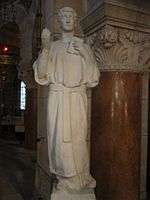Ferreolus and Ferrutio
| Saint Ferreolus and Ferrutio | |
|---|---|
|
Statue of Ferreolus of Besançon. Basilique Saint-Ferjeux, near Besançon. | |
| Died | ~AD 212 |
| Venerated in |
Roman Catholic Church, Eastern Orthodox Church |
| Major shrine | Basilica of Saint-Ferjeux |
| Feast | June 16 |
| Patronage | Besançon |
Saints Ferreolus and Ferrutio (French: Ferréol and Ferjeux; Italian: Ferreolo e Ferruccio) (died ca. AD 212) are venerated as martyrs and saints by the Catholic Church.
History
Their legendary acts state that they were brothers converted to Christianity by Saint Polycarp.[1] They were ordained as priest and deacon, respectively, by Saint Irenaeus of Lyons. They were sent to the area around Besançon as missionaries. They are called natives of Asia Minor;[2] Alban Butler held it "more probable that they were natives of Gaul who had studied in Asia Minor and come under Christian influence."[1]
After working as missionaries amongst the Sequani for 30 years, in AD 212 during the persecution of Alexander Severus, they were arrested, tortured and beheaded.[3]
Veneration

According to their legend, their relics were discovered in a cave near Besançon in AD 370 by a military tribune whose dog was chasing a fox. The relics were enshrined by Bishop Anianus of Besançon in the 4th century AD.[1] Saint Gregory of Tours writes that miracles were attributed to their relics in his time; he says that his brother-in-law was cured of a dangerous distemper at the saints' intercession.[2] The Missale Gothicum (ca. AD 700) contains a full proper of the Mass in their honor.[1] In the sixteenth century, they were invoked in Besançon against sickness, along with Saint Sebastian and Saint Roch.[4]
Ferreolus appears in a catalogue of the 17th century as a bishop of Besançon, but the liturgy of Besançon has always remembered Ferreolus as a priest, and Ferrutio as a deacon.[5] Ferreolus and Ferrutio, as patrons of Besançon, are considered to have appeared on the city walls in times of danger.[5] The two saints have been represented in stained glass, paintings, and statues in many churches and chapels in the two dioceses of the Franche-Comté: Saint-Claude and Besançon.[5]
The Basilique Saint-Ferjeux is situated in the neighborhood of Saint-Ferjeux, Besançon.
They are depicted on a French lantern slide dating from AD 1900.
Gallery
-
Reliquary of Saint Ferrutio. Crypt of the Basilica Saint Ferjeux de Besançon.
Notes
- 1 2 3 4 Alban Butler; Paul Burns, Butler's Lives of the Saints (Continuum International, 2000), 117.
- 1 2 Rabenstein, Katherine (June 1998). "Ferreolus and Ferrutio MM (RM)". Saints O' the Day for June 16. Archived from the original on 2007-11-05. Retrieved 2007-12-10.
- ↑ "Latin Saints of the Orthodox Patriarchate of Rome", Orthodox Europe
- ↑ "L'origine des maladies" (in French). Retrieved 2007-12-10.
- 1 2 3 Borrelli, Antonio (2003-02-06). "Santi Ferreolo e Ferruccio". Santi Beati (in Italian). Retrieved 2007-12-10.
External links
- Saint Ferréol et Saint Fargeau (French)
- Diocèse de Besançon (French)
- Santi Ferreolo e Ferruccio from Santi Beati (Italian)

